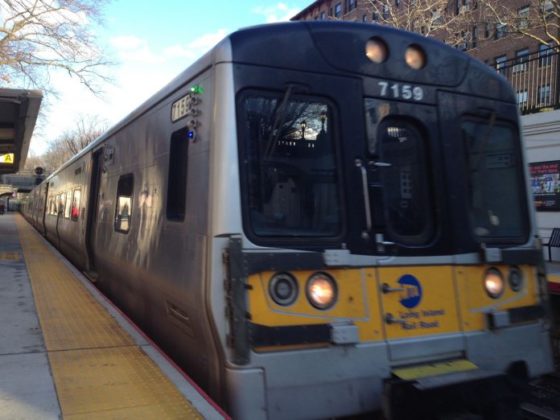As a tumultuous year came to a close, officials from the Long Island Rail Road’s expansion project reflected on the progress made in 2020.
The year in construction was highlighted by reaching the halfway point for completion of the project, which is putting in place nearly 10 miles of a new third track and has worked on making grade crossings safer and upgrading the architecture and technology for stations from Floral Park to Hicksville. Construction for the project began in late 2018 and is projected to be completed in 2022, officials said.
On the North Shore, hazardous grade crossings were removed and bridges were replaced.
Crews worked through one weekend in late June to replace the 78-year-old Glen Cove Road Bridge, which carried the Long Island Rail Road over Glen Cove Road, with a new three-bay structure to allow for a third track. This was the sixth of seven bridges to be replaced or improved as part of the expansion project.
The new bridge is 60 feet long, 45 feet wide, weighs 285 tons, and has a height of 14 feet, a standard clearance height for all new bridges along the corridor. It was assembled in the Macy’s parking lot adjacent to the site and was lifted and rolled into place using specialized heavy-duty equipment after the old bridge was demolished.
The New Hyde Park underpass was completed in August, two months ahead of schedule, according to Gov. Andrew Cuomo.
Cuomo said waiting for the train to pass at the grade crossing that was replaced by the underpass created inconvenience for drivers and was bad for the environment since cars would sit idle while waiting.
“This was a traffic nightmare for decades,” Cuomo said during a news conference at Clinton G. Martin Community Center in New Hyde Park in August. “And it was one of those situations where you would say as you’re going through it, ‘why don’t they fix this.’”
In October, workers finished installing two interlockings, pieces of infrastructure to prepare for installation of the third track. The interlockings will allow trains to move from one track to another with the use of switches.
“Once the LIRR Expansion Project is complete, the interlockings and third track will provide the railroad with the ability to increase service by nearly 50 percent, route trains around problem areas, and provide true bidirectional service during peak morning and afternoon periods,” officials said in an October news release.
October also saw the elimination of the last of three crossings on the Main Line in New Hyde Park as the South 12th Street crossing was permanently closed. Transit authority officials stressed the need for the elimination of grade crossings after six fatal crashes at Main Line corridor crossings from 2007 to 2017.
Platforms at the New Hyde Park station are also being lengthened and positioned to accommodate the Main Line’s new third track.
In early December, Willis Avenue in Mineola closed to vehicle traffic from 3rd to 2nd streets for at least nine months. The MTA said the underpass is the last to be constructed as part of the expansion project.
“The Willis Avenue grade crossing elimination project will help strengthen the reliability of LIRR infrastructure and support the growth and development of Long Island as well as the entire region,” the MTA said in a statement. “In addition, it will enhance safety and provide for a quieter and more livable community along the railroad.”
Despite the improvements on the Long Island Rail Road, the future remains grim for the Metropolitan Transportation Authority in the absence of $12 billion in federal aid after a proposed 2021 budget called for a 50 percent reduction in rail service and a “drastic reduction” to the agency’s workforce due to the coronavirus pandemic.
MTA Chairman and CEO Pat Foye said this financial crisis surpassed the Great Depression’s impact on transit revenue and ridership.
“No one at the MTA wants to undertake these horrific cuts but with federal relief nowhere in sight there is no other option,” Foye said in November. “As I have said, we cannot cut our way out of this crisis.”
A COVID-19 relief bill approved by Congress and signed into law by President Donald Trump on Sunday will provide $4 billion to the MTA, far less than the $12 billion the agency has sought.
Fare and toll revenues, according to the agency’s November plan, are projected to eclipse July estimates by $319 million while nonlabor expenses are projected to be lower by nearly $300 million in 2020. While those projections seem encouraging, the transit authority still faces an immediate $2.5 billion in deficits due to the pandemic. Officials estimated the deficit will grow to $6.1 billion in 2021.
The transit authority proposed cutting 9,367 jobs in various subsidiary organizations such as the Long Island Rail Road, Metro-North, subways and buses. The main layoffs, transit officials said, would come from the city’s subway and bus systems, with nearly 7,000 job cuts proposed in those two areas. The Long Island Rail Road and Metro-North would see a combined 933 layoffs if the proposals are enacted.
“The MTA continues to face a once-in-100-year fiscal tsunami and this is without a doubt one of the most difficult and devastating budgets in agency history,” Foye said. “We are once again urging Washington to take immediate action and provide the full $12 billion to the MTA.”



